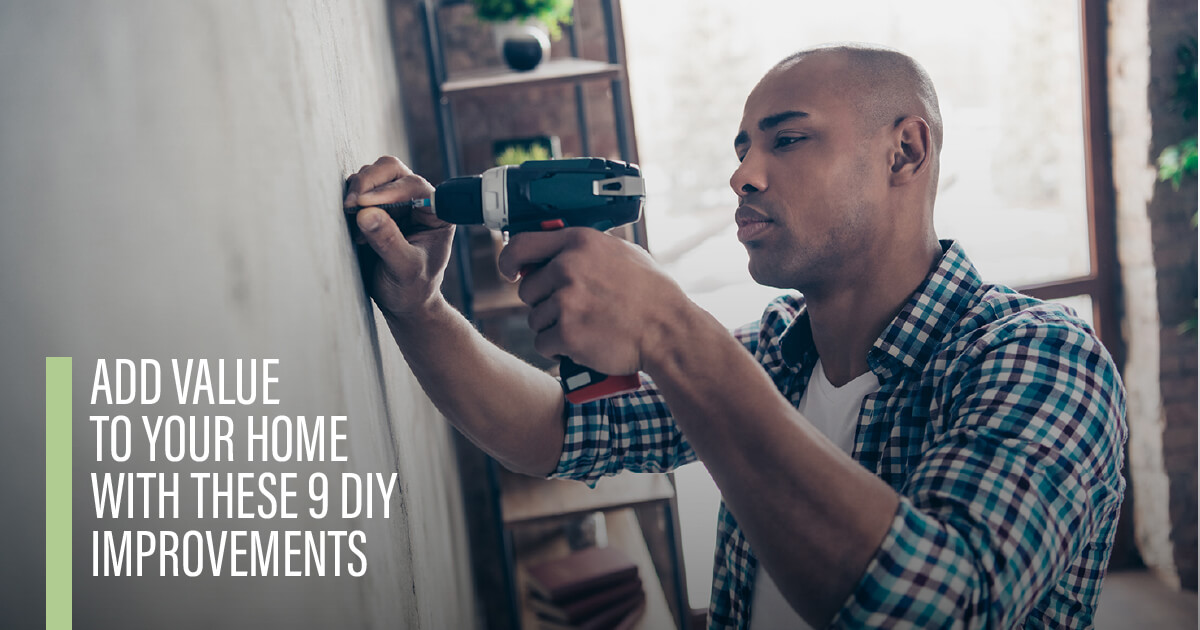Whether you’re prepping your house to go on the market or looking for ways to maximize its long-term appreciation, these nine home improvement projects are great ways to add function, beauty, and real value to your home.
The best part is, once you’ve secured the materials, most of these renovations can be completed over the course of a weekend. And they don’t require a lot of specialized skills or experience. So grab your toolbox, then get ready to boost your home’s appeal AND investment potential!
- Spruce Up Your Landscaping
Landscaping improvements can increase a home’s value by 10-12%.1 But which outdoor features do buyers care about most? According to a survey of Realtors, a healthy lawn is at the top of their list. If your lawn is lacking, overseeding or laying new sod can be a worthwhile investment—with an expected return of 417% and 143% respectively.1
Planting flowers is another great way to enhance your home’s curb appeal. And if you choose a perennial variety, your blooms should return year after year. For an even longer-term impact, consider planting a tree. According to the Council of Tree and Landscape Appraisers, a mature tree can add up to $10,000 to the value of your home.2
- Clean The Exterior
When it comes to making your house shine, a sparkling facade can be just as important as a clean interior. Real estate professionals estimate that washing the outside of a house can add as much as $15,000 to its sales price.3
A rented pressure washer from your local home improvement store can help you remove built-up dirt and grime from your home’s exterior, walkway, and driveway. Just be sure to read the instructions carefully—and only use it on surfaces that can withstand the intensity. When in doubt, a scrub brush and bucket of sudsy water will often do the trick.
- Add A Fresh Coat Of Paint
New paint can have a big impact on both the appearance and value of a property. In fact, it’s one of the most effective ways to revitalize a home’s exterior, update its interior, and make it appear larger and brighter. The best part? Painting is relatively easy and inexpensive!
To get the maximum return at resale, stick with a modern but neutral color palette that will appeal to a broad range of buyers. According to a recent survey of home design experts, cool neutrals are a safe bet when it comes to interior paint. And respondents chose white and gray as the best exterior paint colors to use when selling a home.4 However, it’s important to consider a property’s architecture, existing fixtures, and regional design preferences, as well.
- Install Smart Home Technology
In a recent survey, 78% of real estate professionals said their buyer clients were willing to pay more for a home with smart technology features.5 The most requested smart devices? Thermostats (77%), smoke detectors (75%), home security cameras (66%), and locks (63%).6
The good news is, many of these gadgets are fairly easy to install. And some of them, including smart thermostats and light bulbs, will pay for themselves over time by making your home more energy efficient. In fact, many manufacturers report that smart thermostats can cut back on heating and cooling costs by 10-20%.7
If you already own a smart speaker, like Amazon Alexa or Google Home, choose devices that will pair with your existing technology. This will enable you to create a truly integrated (and in many cases voice-activated) smart home experience.
- Modernize Your Window Treatments
Smart—or motorized—blinds are also growing in popularity, and several manufacturers make models you can order and install on your own. But they’re not the only way to modernize your window treatments.
If you have old aluminum blinds, consider replacing them with plantation shutters, which are energy efficient, durable, and have strong buyer appeal.8 Roman and roller shades are another stylish alternative, and they come in a variety of colors and fabrics, which you can personalize to meet your design and privacy preferences.
Fortunately, upgrading your blinds has gotten easier and less expensive in recent years. There are a number of retailers that specialize in affordable window coverings that are simple to measure and hang yourself.
- Replace Outdated Fixtures
Drastically transform the look and feel of your home by swapping out dingy and dated fixtures for contemporary alternatives. Start by assessing your current light fixtures, faucets, cabinet hardware, door knobs, and even switch plates. Then prioritize replacing those that are particularly outdated or in highly-visible areas, such as your entryway or kitchen.
Even if your home is fairly new, consider trading your builder-grade fixtures for higher-end options to give it a more upscale appearance. And forget the old rule about sticking to one metal tone throughout your property. According to designers, mixing metal finishes can add interest and character to a space.9
For more designer insights and decor trends, contact me for a free copy of my recent report: “Top 5 Home Design Trends for a New Decade.”
- Upgrade Your Bathroom Mirror
A minor bathroom remodel offers one of the best returns on investment, with a $1.71 increase in home value for every $1 you spend.10 We’ve already explored several improvements you can make to your bathroom: new paint, fixtures, and hardware. Now complete the look by upgrading your vanity’s mirror.
Before you purchase a new mirror, examine your existing one to see how it is attached to the wall. Some vanity mirrors are glued to the wall and difficult to remove without shattering the glass or damaging the sheetrock behind it.11
If you prefer to keep your existing mirror, you can paint the frame—or add one if it’s currently frameless. There are several online retailers that will send you the frame components cut to your specifications, which you can assemble and mount yourself. Much like a work of art, your vanity mirror serves as a focal point for your bathroom, so let your creativity shine through!
- Shampoo Your Carpet
Carpet is notorious for trapping dust, dirt, and allergens. It’s one of the reasons that most buyers prefer hard surface flooring.12 But if you love your carpet, or you’re not ready to invest in an alternative, make an effort to keep it clean and odor-free.
To properly maintain your carpet, you should vacuum it weekly. Experts also recommend a deep shampoo at least every two years.13 Fortunately, this is a cheap and easy DIY project you can knock out in about 20 minutes per room. According to Consumer Reports, you can rent a machine and purchase cleaning fluid and supplies for around $90. With an average return on your investment of 169%, it’s well worth the effort and expense.14
- Customize Your Closet
Real estate professionals estimate that a closet remodel can add $2500 to a home’s selling price. And while a professional renovation can cost upwards of $6000, there are many high-quality DIY closet systems you can customize and install yourself.15
Experts recommend taking a thorough inventory of your wardrobe and accessories before you get started. Make sure frequently-worn pieces are easy to reach, and store seasonal and seldom-used items on high shelves. Place shoe racks near the closet entrance so they are easy to access.16 A little planning can go a long way toward building a closet that you (and your future buyers!) will love.
| GET A COMPLIMENTARY ANALYSIS OF YOUR PROJECT
I’ve been talking averages. But the truth is, the actual impact of a home improvement project will vary depending on your particular home and neighborhood. Before you get started, contact me to schedule a free virtual consultation. I can help you determine which upgrades will offer the greatest return on your effort and investment. |
Sources:
- HomeLight –
https://www.homelight.com/blog/improve-curb-appeal-landscaping/ - National Association of Realtors –
https://www.realtor.com/advice/home-improvement/landscape-renovations-that-pay-off/ - com – https://www.houselogic.com/save-money-add-value/add-value-to-your-home/adding-curb-appeal-value-to-home/
- Fixr –
https://www.fixr.com/blog/2020/01/14/paint-color-trends-in-2020/ - T3 Sixty –
https://blog.coldwellbanker.com/wp-content/uploads/2018/01/CES2018-Smart-Homes-An-Emerging-Real-Estate-Opportunity.pdf - Consumer Reports –
https://www.consumerreports.org/smart-home/smart-home-tech-upgrades-to-help-sell-your-house/ - American Council for Energy Efficient Economy
https://www.aceee.org/sites/default/files/publications/researchreports/a1801.pdf - Forbes – https://www.forbes.com/sites/trulia/2016/07/05/10-upgrades-under-1000-that-increase-home-values-2/#47b0d3162e60


 Facebook
Facebook
 X
X
 Pinterest
Pinterest
 Copy Link
Copy Link














